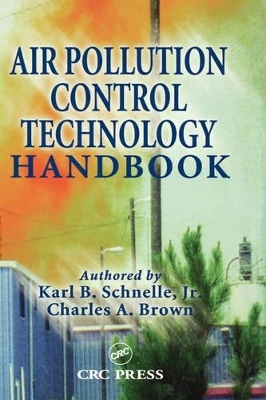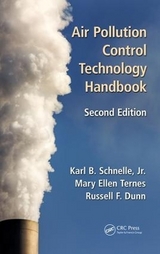
Air Pollution Control Technology Handbook
Crc Press Inc (Verlag)
978-0-8493-9588-8 (ISBN)
- Titel erscheint in neuer Auflage
- Artikel merken
In the debate over pollution control, the price of pollution is a key issue. But which is more costly: clean up or prevention? From regulations to technology selection to equipment design, Air Pollution Control Technology Handbook serves as a single source of information on commonly used air pollution control technology. It covers environmental regulations and their history, process design, the cost of air pollution control equipment, and methods of designing equipment for control of gaseous pollutants and particulate matter.
This book covers how to:
Review alternative design methods
Select methods for control
Evaluate the costs of control equipment
Examine equipment proposals from vendors
With its comprehensive coverage of air pollution control processes, the Air Pollution Control Technology Handbook is a detailed reference for the practicing engineer who prepares the basic process engineering and cost estimation required for the design of an air pollution control system. It discusses the topics in depth so that you can apply the methods and equations presented and proceed with equipment design.
A HISTORICAL OVERVIEW OF THE DEVELOPMENT OF CLEAN AIR REGULATIONS
A Brief History of the Air Pollution Problem
Federal Involvement in Air Pollution Control
Characterizing the Atmosphere
Recipe for an Air Pollution Problem
References
CLEAN AIR ACT
History of the Clean Air Act
1990 Clean Air Act Amendments
References
AIR PERMITS FOR NEW SOURCE
Elements of a Permit Application
Best Available Control Technology
Air Quality Analysis
NSR Reform
References
ATMOSPHERIC DIFFUSION MODELING FOR PSD PERMIT REGULATIONS
Introduction - Meteorological Background
The Tall Stack
Classifying Sources by Method of Emission
Atmospheric-Diffusion Models
EPA Computer Programs for Regulation of Industry
The Source-Transport-Receptor Problem
References
SOURCE TESTING
Introduction
Code of Federal Regulations
Representative Sampling Techniques
References
AMBIENT AIR QUALITY AND CONTINUOUS EMISSIONS MONITORING
Ambient Air Quality Sampling Program
Objectives of a Sampling Program
Monitoring Systems
Federal Reference Methods and Continuous Monitoring
The "Complete" Environmental Surveillance and Control System
Typical Air Sampling Train
Integrated Sampling Devices for Suspended Particulate Matter
Continuous Air Quality Monitors
References
COST ESTIMATING
Time Value of Money
Types of Cost Estimates
Air Pollution Control Equipment Cost
References
PROCESS DESIGN AND THE STRATEGY OF PROCESS DESIGN
Introduction to Process Design
The Strategy of Process Design
Mass and Energy Balances
References
PROFITABILITY AND ENGINEERING ECONOMICS
Introduction - Profit Goal
Profitability Analysis
The Effect of Depreciation
Capital Investment and Total Product Cost
References
INTRODUCTION TO CONTROL OF GASEOUS POLLUTANTS
Absorption and Adsorption
References
ABSORPTION FOR HAP AND VOC CONTROL
Introduction
Aqueous Systems
Nonaqueous Systems
Types and Arrangements of Absorption Equipment
Design Techniques for Countercurrent Absorption Columns
Countercurrent Flow Packed Absorption Tower Design
Sample Design Calculation
References for Absorption
ADSORPTION FOR HAP AND VOC CONTROL
Introduction to Adsorption Operations
Adsorption Phenomenon
Adsorption Processes
Nature of Adsorbents
The Theories of Adsorption
Adsorption Isotherms
Polanyi Potential Theory
Unstady-State Fixed-Bed Adsorbers
Fixed Bed Adsorber Design Considerations
Pressure Drop Through Adsorbers
Adsorber Effectiveness and Regeneration
Breakthrough Model
Regeneration Modeling
References
THERMAL OXIDATION FOR VOC CONTROL
Combustion Basics
Flares
Incineration
Catalytic Oxidation
References
CONTROL OF VOC AND HAP BY CONDENSATION
Introduction
VOC Condensers
Coolant and Heat Exchanger Type
Mixtures of Organic Vapors
Air as a Noncondensable
References
Appendix A: Derivation of the Area Model for a Mixture Condensing from a Gas
Appendix B: Algorithm for the Area
Model for a Mixture Condensing from a Gas
CONTROL OF VOC AND HAP BY BIOFILTRATION
Introduction
Theory of Biofilter Operation
Design Parameters and Conditions
Biofilter Compared to Other Available Control Technology
Successful Case Studies
Further Considerations
References
MEMBRANE SEPARATION
Overview
Polymeric Membranes
Performance
Applications
References
NOX CONTROL
NOX from Combustion
Control Techniques
References
CONTROL OF SOX
H2S Control
SO2 (and HCI) Removal
SO3 and Sulfuric Acid
References
FUNDAMENTALS OF PARTICULATE CONTROL
Particle Size Distribution
Aerodynamic Diameter
Cunningham Clip Correction
Collection Mechanisms
References
HOOD AND DUCTWORK DESIGN
Introduction
Hood Design
Duct Design
Effect of Entrance into a Hood
Total Energy Loss
Fan Power
Hood-Duct Example
References
CYCLONE DESIGN
Collection Efficiency
Pressure Drop
Saltation
References
DESIGN AND APPLICATION OF WET SCRUBBERS
Introduction
Collection Mechanisms and Efficiency
Collection Mechanisms and Particle Size
Selection and Design of Scrubbers
Devices for Wet Scrubbing
The Semrau Principle and Collection Efficiency
A Model for Counter-Current Spray Scrubbers
A Model for Venturi Scrubbers
The Calvert Cut Diameter Design Technique
The Cut-Power Relationship
References
Appendix: Calvert Performance Cut Diameter Data
FILTRATION AND BAGHOUSES
Introduction
Design Issues
Cleaning Mechanisms
Fabric Properties
Baghouse Size
Pressure Drop
Bag Life
References
ELECTROSTATIC PRECIPITATORS
Early Development
Basic Theory
Practical Application of Theory
Flue Gas Conditioning
Using V/I Curves for Troubleshooting
INDEX
| Erscheint lt. Verlag | 18.10.2001 |
|---|---|
| Zusatzinfo | 13 Halftones, black and white; 55 Tables, black and white; 400 Illustrations, black and white |
| Verlagsort | Bosa Roca |
| Sprache | englisch |
| Maße | 156 x 234 mm |
| Gewicht | 708 g |
| Themenwelt | Schulbuch / Wörterbuch ► Lexikon / Chroniken |
| Naturwissenschaften ► Biologie ► Ökologie / Naturschutz | |
| Technik ► Bauwesen | |
| Technik ► Elektrotechnik / Energietechnik | |
| Technik ► Umwelttechnik / Biotechnologie | |
| ISBN-10 | 0-8493-9588-7 / 0849395887 |
| ISBN-13 | 978-0-8493-9588-8 / 9780849395888 |
| Zustand | Neuware |
| Haben Sie eine Frage zum Produkt? |
aus dem Bereich



